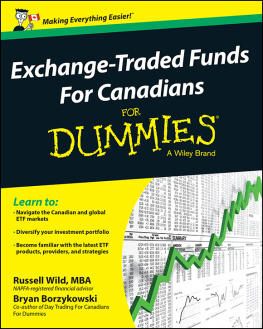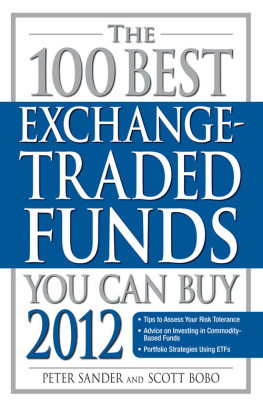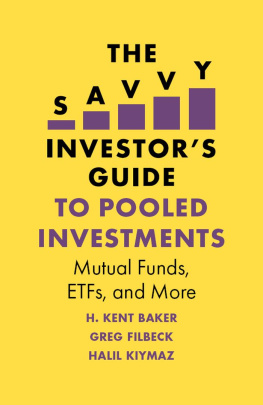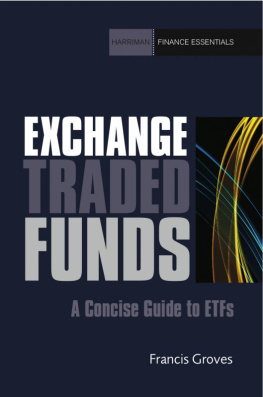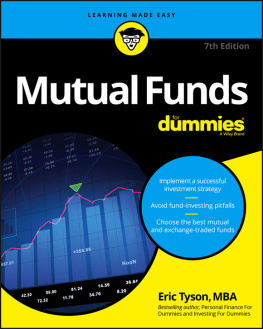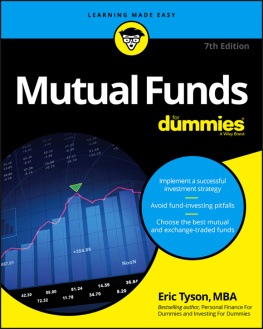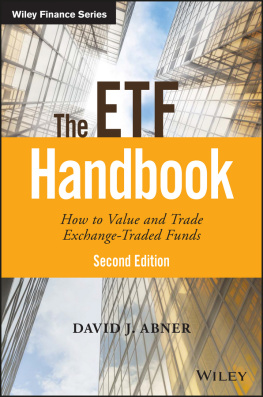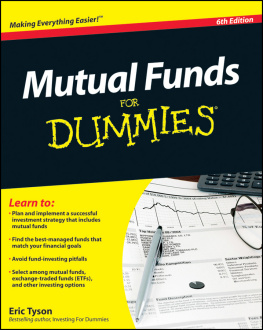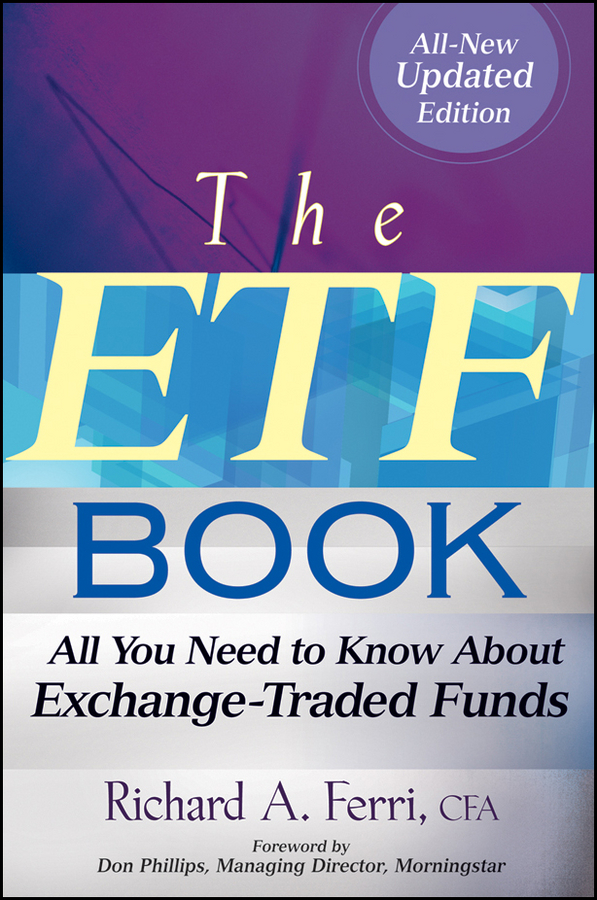Contents
Books by Richard A. Ferri
The ETF Book
All About Index Funds
All About Asset Allocation
Protecting Your Wealth in Good Times and Bad
Serious Money: Straight Talk About Investing for Retirement

Copyright 2008, 2009 by Richard A. Ferri. All rights reserved.
Published by John Wiley & Sons, Inc., Hoboken, New Jersey.
Published simultaneously in Canada.
No part of this publication may be reproduced, stored in a retrieval system, or transmitted in any form or by any means, electronic, mechanical, photocopying, recording, scanning, or otherwise, except as permitted under Section 107 or 108 of the 1976 United States Copyright Act, without either the prior written permission of the Publisher, or authorization through payment of the appropriate per-copy fee to the Copyright Clearance Center, Inc., 222 Rosewood Drive, Danvers, MA 01923, (978) 750-8400, fax (978) 646-8600, or on the Web at www.copyright.com . Requests to the Publisher for permission should be addressed to the Permissions Department, John Wiley & Sons, Inc., 111 River Street, Hoboken, NJ 07030, (201) 748-6011, fax (201) 748-6008, or online at http://www.wiley.com/go/permissions .
Limit of Liability/Disclaimer of Warranty: While the publisher and author have used their best efforts in preparing this book, they make no representations or warranties with respect to the accuracy or completeness of the contents of this book and specifically disclaim any implied warranties of merchantability or fitness for a particular purpose. No warranty may be created or extended by sales representatives or written sales materials. The advice and strategies contained herein may not be suitable for your situation. You should consult with a professional where appropriate. Neither the publisher nor author shall be liable for any loss of profit or any other commercial damages, including but not limited to special, incidental, consequential, or other damages.
For general information on our other products and services or for technical support, please contact our Customer Care Department within the United States at (800) 762-2974, outside the United States at (317) 572-3993 or fax (317) 572-4002.
Wiley also publishes its books in a variety of electronic formats. Some content that appears in print may not be available in electronic formats. For more information about Wiley products, visit our Web site at www.wiley.com .
Library of Congress Cataloging-in-Publication Data
Ferri, Richard A.
The ETF book: all you need to know about exchange-traded funds / Richard A. Ferri; foreword by Don Phillips.
p. cm.
Includes indexes.
ISBN 978-0-470-53746-6 (cloth)
1. Exchange traded funds. I. Title.
HG6043.F47 2009
332.6327dc22
2009017153
The ETF Book is dedicated to all the brave men and women in the armed forces who protect our country, our freedoms, and our way of life. They give everything and ask for nothing except our unwavering support.
The authors royalties from the sale of this book are donated to a nonprofit organization assisting wounded veterans and their families.
Semper Fi
Foreword
Theres no topic in personal finance today thats hotter than exchange-traded funds (ETFs). Diehard believers in passive investing love the low costs and broad diversification available through ETFs. Traders and market timers love the ability to buy and sell on an intra-day basis, and they cherish the growing number of highly specialized offerings that allow them to execute far more sophisticated strategies than ever before. Even active managers are getting in on the scene, using ETFs to equitize their cash positions and imagining a future where actively managed ETFs will be widely available. Never before have so many investors embraced a financial concept so rapidly and for such a wide variety of reasons as they have with exchange-traded funds.
The ETF phenomenon is perhaps most revolutionary from the individual investors perspective. For years, there was a gulf between what was possible for institutional investors and what the little guy could do. Like many small investors, I recall reading about the global wanderings of legendary investor Jim Rogers, author of Investment Biker and other significant investment books. Rogers would observe global events and turn them into investment ideas, often shorting certain currencies, going long various commodities, and making bets on specific subsectors of a market, such as Japanese small companies. I was dazzled by his insight but was frustrated by my own inability to act upon such insights even if I could be as clever as Rogers in identifying them. Sure, I could buy shares in an international equity fund or a precious metals fund, but I couldnt be sure that the funds manager was making the bets that I wanted. And even if I did identify a manager who seemed to have his portfolio aligned the way I wanted it to be, there was no guarantee that positioning would stay in place. Simply put, there was no way that I could do what Rogers did, even if I had the right ideas.
Exchange-traded funds have changed all that. Today the toolkit available to individual investors is bigger and better than ever before. Highly specialized precision investment instruments are now part of the small investors arsenal. If you want to bet on the fortunes of pharmaceutical stocks or regional banks, theres an ETF for you. If you want to play the real estate market, there are multiple ETFs available for that purpose, investing in either domestic or international real estate. If you want to bet on companies that might find a cure for cancer or invest only in companies that dont do business in Somalia, theres an ETF for you. If you want to bet on companies known for innovation, ones that are leaders in their field, or ones that are followed by only a small number of analysts, theres an ETF for you. And all of these bets can go in either direction, as ETFs can be bought long or sold short. Theres little to no limit to what an investor may do today; almost any choice is possible.
Of course, more choices dont guarantee better results. Some highly respected investment commentators, most notably Vanguard founder Jack Bogle, have criticized the narrow focus of many ETFs and the overall push toward more frequent trading that some investors adopt when given greater opportunity to adjust their portfolios. Indeed, the basic concept of indexing is to buy and hold the entire market, something that seems at odds with the product proliferation and intraday trading of ETFs. So, while ETFs benefit from the goodwill created by the index movement, they can clearly be used for purposes that range far from the basic premise that underlies indexation. Bogle graphically captures the dual possibilities of ETFs when he likens them to a finely honed shotgun that can be used either for survival or for murder.
The reasons that ETFs have become so specialized so quickly are easy to understand. In the actively managed fund world, every shop can have its own broadly diversified large-cap stock fund, as the chance that it may outperform may make it an economically viable offering. In the ETF world, where passive strategies dominate, theres less reason for each shop to have a broad-based equity index fund. Once a handful of these funds exist, theres little reason for more. Accordingly, newer players in the market move quickly to fill more esoteric niches in order to be the first player in a new part of the market. The result has been a rush toward producing more narrowly defined funds that tend to have higher volatility than broadly diversified ones. Indeed, the volatility of the ETF market has moved systematically higher over the past decade, with the most volatile offerings, ones that leverage or short the market, coming in the past 12 months.


